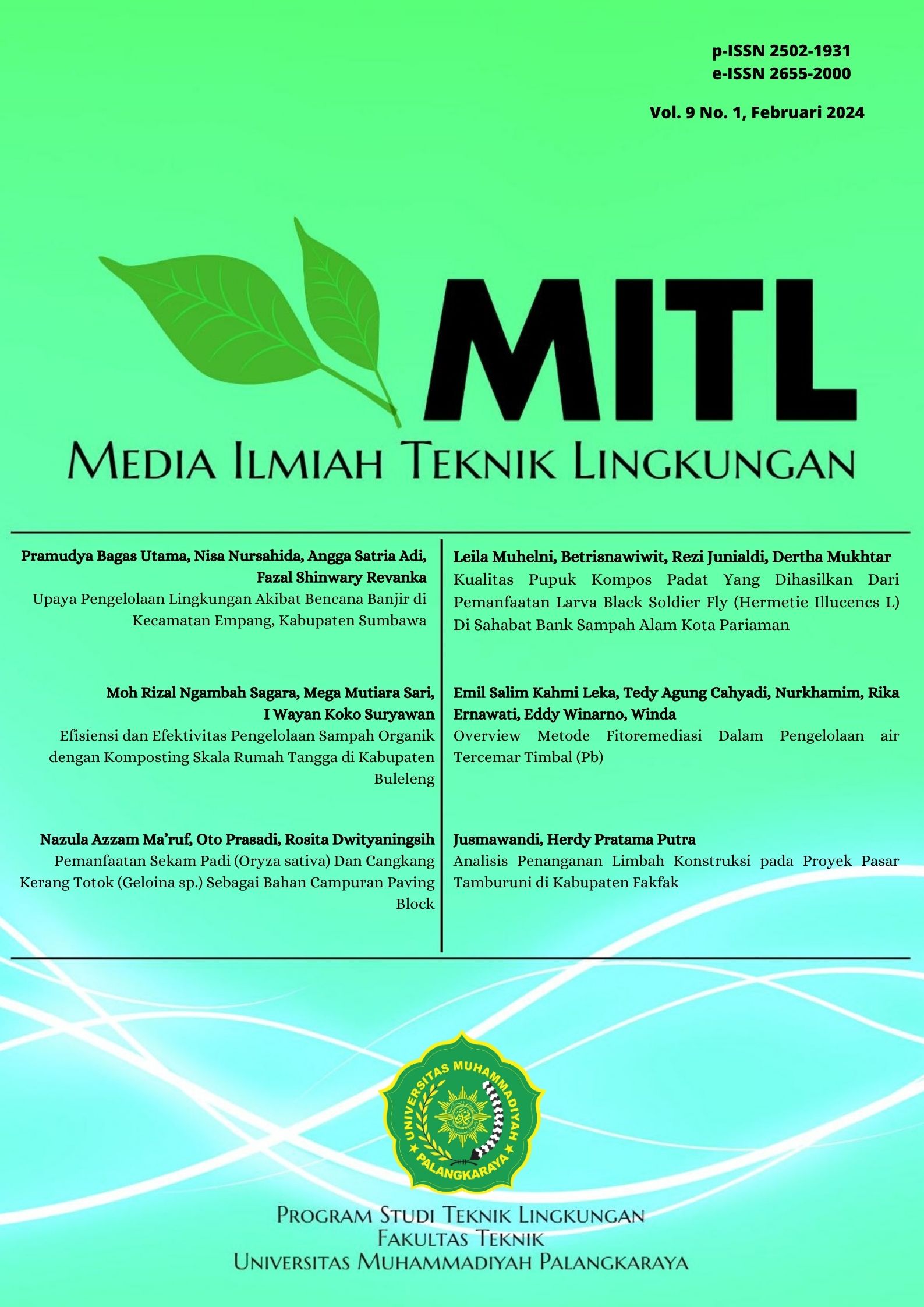Pemanfaatan Sekam Padi (Oryza sativa) Dan Cangkang Kerang Totok (Geloina sp.) Sebagai Bahan Campuran Paving Block Utilization of Rice Husks (Oryza sativa) and Totok Shells (Geloina sp.) as Paving Block Mixtures
Main Article Content
Abstract
Shellfish shells and rice husks can be processed into charcoal and ash. Shellfish ash and rice husk charcoal contain chemical compounds such as pozzolan, lime (CaO), alumina and silica compounds which can replace cement in paving block mixtures. The use of rice husk charcoal and full-blooded clam shell ash as an alternative provides stronger pressure resistance. This research aims to determine the effect of the composition of a mixture of shell ash and rice husk charcoal on the quality of paving blocks. The results of this research were a mixture of composition A3 (2:1) with 66.6 grams of rice husks and 33.3 grams of full-blooded clam shells as well as 500 grams of cement and 1500 grams of sand, resulting in a compressive strength of 14.3 Mpa and was classified as C. Composition A5 (3:1) mixture with 25 grams of rice husks and 75 grams of full-blooded clam shells as well as 500 grams of cement and 1500 grams of sand, produces a compressive strength of 16.7 Mpa and is classified as B. Meanwhile, the composition of the A0 (0:0) mixture without A mixture of rice husks and shells only produces a compressive strength of 9.05 Mpa and is classified as D. The conclusion of the research is that paving blocks of composition A5 show the best water absorption quality with water absorption results of 7.69%.
Downloads
Article Details

This work is licensed under a Creative Commons Attribution-ShareAlike 4.0 International License.
All rights reserved. This publication may be reproduced, stored in a retrieval system, or transmitted in any form or by any means, electronic, mechanical, photocopying, recording.
References
A. Hidayat, "Pengaruh Penambahan Cangkang Kerang Sebagai Campuran Terhadap Kuat Tekan Dan Daya Serap Air Pada Paving Block," Universitas Islam Riau , Pekanbaru, 2020.
R. Rahayu, T. Leksoni and Desmelati, "Analisis Kandungan Mineral pada Tepung Cangkang Kerang Air Tawar (Pilsbryoconcha exilis) Berdasarkan Ukuran Cangkang yang Berbeda," Journal Onlline Mahasiswa UNRI, 2015. URL: https://jom.unri.ac.id/index.php/JOMFAPERIKA/article/download/6938/6626
N. Prameswari, A. Razak and D. Mulawarmanti, "Prameswari N, Razak A, Mulawarmanti D. 2013. Efektvitas Diet Kombinasi Susu Kedelai dan Tepung Kulit Cangkang Kerang Hijau dalam Meningkatkan Panjang Lengkung Rahang. Jurnal Material Kedokteran Gigi Vol. 2(1) : 51- 59," Jurnal Material Kedokteran Gigi, vol. 2, no. 1, pp. 51-59, 2013. URL: http://jurnal.pdgi.or.id/index.php/jmkg/article/view/192
M. E. Hoque, M. Shehryar and K. M. N. Islam, "Processing and Characterization of Cockle Shell Calcium Carbonate (CaCO3) Bioceramic for Potential Application in Bone Tissue Engineering," Wood Material Science and Engineering, vol. 2, no. 4, pp. 1-5, 2013. DOI: http://dx.doi.org/10.4172/2169-0022.1000132
A. R. Yusuf and Hijriah, "Teknologi Pemanfaatan Limbah Abu Sekam Padi menjadi Paving Block," Jurnal Dedikasi, vol. 21, no. 2, pp. 139-143, 2019. URL: https://doi.org/10.26858/dedikasi.v21i2.11484
R. Akmalia, M. Olivia and A. Kamaldi, "Kuat Tekan dan Sorptivity Beton Dengan Serbuk Kulit Kerang (Anadara Granosa)," Jurnal Online Mahasiswa Fakultas Teknik, vol. 3, no. 2, 2016. URL: https://jom.unri.ac.id/index.php/JOMFTEKNIK/article/view/9814
Badan Standarisasi Nasional, Standar Nasional Indonesia 03-0691-1996 Tentang Bata Beton (Paving-Block), BSN, 1996.
E. J. Kusuma, "Pemanfaatan Limbah Kulit Kerang Sebagai Bahan Campuran Pembuatan Paving Block," UPN Veteran Jatim, Surabaya, 2017.
F. Lifnastiti, "Pengaruh Variasi Penambahan Fly Ash Sebagai Pengganti Sebagian Semen Terhadap Mutu Paving Block," Universitas Islam Indonesia, Yogyakarta, 2020.
